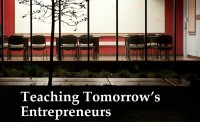(This article originally appeared in Mediashift.)
So far, two cohort groups, some 21 people, have gone through my Seminar in Media Entrepreneurship for mid-career professionals. It is the first seminar that each cohort group takes as they embark on the 20-month, 10-course journey to a MA in Media Entrepreneurship at American University.
As entrepreneurship courses increasingly multiply in journalism school curricula, many questions arise, and many opportunities do, too.

Photo: Paul Goyette | Creative Commons.
Here are 10 takeaways from my experience to date.
1. Have a startup idea in mind before the course begins.
It may not be the project students will present for their capstone, but if they have to think of a venture after they begin their course work, they will quickly fall behind.
2. Vet students’ passion to launch something and the creativity of their idea as criteria for admission.
Don’t require GREs or even high GPAs. Neither count for much in the entrepreneurship space.
3. Consider using Pandora, the Internet radio service, to market your program.
Every student in my class said they had heard about the program while listening to music.
4. Define “media” broadly.
It’s clear that my students regard media entrepreneurship as more than journalism; it is any kind of digital information or toolkit. And who knows? The emerging pattern has media startups adding journalism capabilities as they grow. Consider how the expansion of such digital information deliverers as Buzzfeed and Twitter has whetted their appetites for bonafide journalism and led to recent hires of news editors with journalism chops.

American University’s DC Startup Forum series helps spread entrepreneurial ideas.
5. Require students to think of their startup as accomplishing a “job [that needs] to be done.”
I’ve found this to be a useful framework. As disruptive technology guru Clay Christensen notes, people don’t buy products; they buy solutions to problems they encounter.
6. Present, present, present.
I require student to distill their epiphanies from class assignments into very short, 3- to 5-page wrap-ups accompanied by an AV presentation to the entire class. They’ve used Powerpoint, Keynote, Prezi and SlideRocket for presentations that got increasingly sophisticated week by week. By the end of the semester, they had a focused pitch deck. They even scheduled their own sharing session to teach one another multimedia presentation tricks.
7. Get permission to publicize their ideas – on your website and to the rest of the school.
While some students want to stick to the non-disclosure route, others will find support and help by being open. In the future, I’d like to invite interested faculty and students to their final project presentations.
8. Partner with nearby accelerators to expose students to the local startup scene.
American University is the first university to partner with 1776, a year-old incubator in Washington, D.C. that has attracted scores of fledgling enterprises. Students and faculty can work at the AU table and attend some presentations. Faculty have begun sharing their expertise in clinics for 1776’ers.
9. Launch a speaker series, not just for media entrepreneurship students but other students as well.
Our DC Startup Forum presents local entrepreneurs in monthly, hour-long Q&As during spring and fall semesters. WAMU public radio uploads video of the sessions. They also appeal to budding social entrepreneurs at AU’s School of International Services and business entrepreneurs at the Kogod School of Business.

Dan Pacheco
10. Aim for a prototype or minimum viable product.
This is a key challenge for many media entrepreneurship programs. If extra programming skills are needed, consider bringing on a Visiting Programmer for 10 to 12 hours a week who can help jumpstart student ideas. Credit for this idea goes to Dan Pacheco at Syracuse.
One idea leads to another and the routes to new opportunities have been surprising. There is no shortage of good ideas for the future of news and information.







Comments are closed.